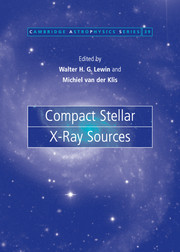Book contents
- Frontmatter
- Contents
- List of contributors
- Preface
- 1 Accreting neutron stars and black holes: a decade of discoveries
- 2 Rapid X-ray variability
- 3 New views of thermonuclear bursts
- 4 Black hole binaries
- 5 Optical, ultraviolet and infrared observations of X-ray binaries
- 6 Fast X-ray transients and X-ray flashes
- 7 Isolated neutron stars
- 8 Globular cluster X-ray sources
- 9 Jets from X-ray binaries
- 10 X-rays from cataclysmic variables
- 11 Super-soft sources
- 12 Compact steller X-ray sources in normal galaxies
- 13 Accretion in compact binaries
- 14 Soft gamma repeaters and anomalous X-ray pulsars: magnetar candidates
- 15 Cosmic gamma-ray bursts, their afterglows, and their host galaxies
- 16 Formation and evolution of compact stellar X-ray sources
- Author index
- Subject index
6 - Fast X-ray transients and X-ray flashes
Published online by Cambridge University Press: 01 September 2009
- Frontmatter
- Contents
- List of contributors
- Preface
- 1 Accreting neutron stars and black holes: a decade of discoveries
- 2 Rapid X-ray variability
- 3 New views of thermonuclear bursts
- 4 Black hole binaries
- 5 Optical, ultraviolet and infrared observations of X-ray binaries
- 6 Fast X-ray transients and X-ray flashes
- 7 Isolated neutron stars
- 8 Globular cluster X-ray sources
- 9 Jets from X-ray binaries
- 10 X-rays from cataclysmic variables
- 11 Super-soft sources
- 12 Compact steller X-ray sources in normal galaxies
- 13 Accretion in compact binaries
- 14 Soft gamma repeaters and anomalous X-ray pulsars: magnetar candidates
- 15 Cosmic gamma-ray bursts, their afterglows, and their host galaxies
- 16 Formation and evolution of compact stellar X-ray sources
- Author index
- Subject index
Summary
Introduction
The X-ray sky is extremely variable. Transient sources occur on probably all timescales. Historically, the easiest timescales to study are seconds to minutes, and days to months. Most of these transients are Galactic in origin and have been shown to be powered by gravitational energy release during accretion of matter onto a compact object or by thermonuclear runaway processes on neutron stars (see Chapter 3 by Strohmayer and Bildsten). Less well understood are the transients with timescales between a minute and a day, the so-called “fast X-ray transients” (FXTs). These often occur off the Galactic plane and are, therefore, sometimes also referred to as “high latitude transients” (see Fig. 6.1). In general an FXT is loosely defined as a new temporary X-ray source that disappears on a timescale of less than a day and is not related to a known persistent X-ray source. The term, however, has been used as a repository for all sorts of ill-understood flares, bursts, flashes and related phenomena.
The early detections of fast X-ray transients
The very first X-ray satellite, Uhuru, detected fast transient X-ray sources (Forman et al. 1978), but it was through studies with Ariel-V (Pye & McHardy 1983) and the High Energy Astronomy Observatory-1 (HEAO-1) (Ambruster & Wood 1986; Connors et al. 1986) that FXTs came to be recognized as a separate class of transients.
- Type
- Chapter
- Information
- Compact Stellar X-ray Sources , pp. 267 - 278Publisher: Cambridge University PressPrint publication year: 2006
- 2
- Cited by



